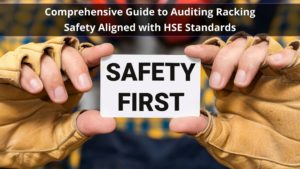
The humble safety pins might not be much to look at, but its history can tell us a lot about rack safety inspections, health and safety law, and society in general
For such a simple piece of technology, the safety pin has almost limitless applications. Throughout its history, it’s gone from a simple solution to a small potential danger to a fashion accessory cum political symbol. How did this all happen? And what can it tell us about pallet racking safety, rack safety inspections, and the development of health and safety in general?
Modest Beginnings for a Modest Innovation
In 1834, New York mechanic Walter Hunt was twisting a piece of wire between his fingers while racking his brains; he was trying to figure his way out of a $15 debt. In the 19th Century, this was a lot of money, but not nearly as much money as Walter would eventually run into. This is because, as Walter was twisting that fateful wire between fingers, he came up with an idea: a pin which would fold over into a clasp to keep whatever it was fixing into place both safe and secure. The safety element of this pin is what attracted him the most to the idea, which is why he eventually called it the “safety pin”.
Instead of giving the man he owed $15, he instead traded him the rights to his safety pin patent for $400. Walter was clear from debt, $400 richer, and the world had just been make a little bit safer.
Anarchy and Safety: The Safety Pin’s Role in the History of Punk Rock
There’s something ironic about an invention designed to make people safer becoming such an iconic symbol of punk rock, a movement which laughed in the face of safety — and probably spat in it too. During an era made infamous by the Sex Pistols singing an anti-establishment, republican anthem on the same day as Queen Elizabeth’s Silver Jubilee, the humble safety pin’s role was to keep people’s clothes held together after they had been torn apart by mosh pits and heavy drinking.
Though punk rock embraced the safety pin in a somewhat unexpected way, the music of The Clash and The Damned is undoubtedly a million miles away from pallet racking inspection training. However, pallet racking inspection training is intimately tie with the safety pin and the history of workplace safety…
What do Safety Pins and Rack Safety Inspections Have in Common?
Both safety pins and rack safety inspections are simple solutions to problems which, from a distance, may look small but is in fact cumulatively large. Moreover, both solutions have had a huge important on the world of work.
For example, it’s no surprise that safety pins were invent around the same time as the Market Revolution in the US and the Industrial Revolution in the UK. Neither revolutions involved wars or changes in political leaders. However, they were both truly revolutionary in the sense that they forever changed the way that British citizens, American citizens, and citizens from countries across the whole world lived their lives.
The invention of the safety pin was part of a larger movement towards the standardisation and professionalisation of the American workplace. An artisan’s “price” was replaced with the notion of a worker’s “wage”, the working day became regulated rather than a matter of when the sun set, and the clumsy pin used for making clothes for hundreds of years was replaced with a simpler, safer, and repeatable design. If all of this seems disconnected, it’s worth remembering that the inventor of the safety pin — Walter Hunt — also invented several of the most important innovations to the modern sewing machine. A design which allowed for the rise of the mass production of clothes in both the US and the UK.
The safety pin is part of the proud history of the workplace. However, as work became faster and more factory orientated, a huge number of workplace accidents started to happen. Work fatalities were at an all-time high in the UK and so it was that safety standards — such as rack safety inspections and pallet racking inspection training — were introduce into the workplace. Of course, this didn’t happen straight away. Progress can sometimes be slow. As a result, there are almost 100 years between the establishment of some the first workplace safety regulations in the UK and the foundation of HSE: a powerful government body that could create, and properly enforce, the UK’s safety laws.
Pallet Racking Inspection Training, Rack Safety Inspections, and the Safety Pin Today
If safety pins are an underappreciated part of the history of professionalism in the workplace, then rack safety inspections and pallet racking training are an underappreciated part of the history of safety in the workplace. Today safety pins take on a new role, as a symbol for people to show solidarity with victims of discrimination, but they take this role alongside their vital role in the history of the workplace.
Rack safety inspections, like the safety pin, are much more than they seem. Though we don’t envision them becoming as intimately entwined with a musical subculture as safety pins were with British punk music, we can personally guarantee that our rack safety inspections and pallet racking inspection training will continue to be on the right side of the history of workplace safety.
Be on the right side of workplace safety history with a pallet racking inspection training course or rack safety inspections from Industrial Storage Equipment Experts.





